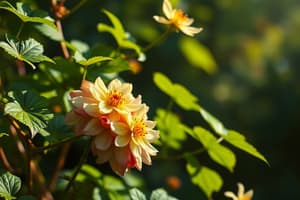Podcast
Questions and Answers
What is the primary function of chlorophyll in plants?
What is the primary function of chlorophyll in plants?
- It protects the plant from pests.
- It stores nutrients in the plant.
- It helps in water absorption.
- It captures sunlight for energy. (correct)
Heterotrophs are organisms that can produce their own food from inorganic substances.
Heterotrophs are organisms that can produce their own food from inorganic substances.
False (B)
Name one example of an insectivorous plant.
Name one example of an insectivorous plant.
Pitcher plant
The process by which plants convert carbon dioxide and water into food using sunlight is called __________.
The process by which plants convert carbon dioxide and water into food using sunlight is called __________.
Match the following terms with their definitions:
Match the following terms with their definitions:
What is saprotrophic nutrition?
What is saprotrophic nutrition?
Plants that exhibit saprotrophic nutrition are known as parasites.
Plants that exhibit saprotrophic nutrition are known as parasites.
What kind of relationship is established when organisms share shelter and nutrients?
What kind of relationship is established when organisms share shelter and nutrients?
Organisms that digest dead and decaying organic matter are called __________.
Organisms that digest dead and decaying organic matter are called __________.
Match the following terms related to nutrition:
Match the following terms related to nutrition:
Flashcards are hidden until you start studying
Study Notes
Nutrition Overview
- Nutrition refers to how organisms acquire and utilize food.
- Autotrophic nutrition involves organisms synthesizing food from simple inorganic substances such as carbon dioxide and water.
Key Components of Photosynthesis
- Chlorophyll is the green pigment in plants essential for capturing sunlight energy.
- Photosynthesis occurs when green plants convert carbon dioxide and water into carbohydrates and oxygen, facilitated by sunlight and chlorophyll.
- Chemical equation: $Carbon \ dioxide + Water \xrightarrow{Sunlight} \xrightarrow{Chlorophyll} Carbohydrate + Oxygen$
Cell Structure
- Living organisms are composed of cells, the basic unit of life.
- Cells are enclosed by a membrane, containing cytoplasm and a centrally located nucleus.
Dependence on Green Plants
- Almost all living organisms rely directly or indirectly on the food produced by green plants.
Algae
- Algae are simple, aquatic plants lacking differentiated stems, roots, and leaves, characterized by their green color due to chlorophyll.
- Algae synthesize their food through photosynthesis.
Heterotrophs and Their Dependence
- Heterotrophs are organisms that cannot produce their own food and rely on other organisms for sustenance, including animals and non-green plants.
Parasites and Hosts
- Parasites derive nutrients from host organisms without benefiting them; examples include Cuscuta (Amarbel) and lice.
- Hosts provide nutrients to parasites but receive no benefits in return.
Insectivorous Plants
- Insectivorous plants trap and digest insects to obtain nitrogen, which is not available from the soil.
- These plants can perform photosynthesis but require insects for nitrogenous nutrients; examples include the pitcher plant, sundew, and bladderwort.
Saprotrophic Nutrition
- Saprotrophic nutrition involves digesting dead and decaying organic matter by secreting enzymes, followed by the absorption of nutrients in solution form.
- Saprotrophs (or saprophytes) are plants that utilize this mode of nutrition.
Symbiotic Relationships
- Some organisms coexist and share shelter and nutrients, creating a symbiotic relationship where both parties benefit.
Studying That Suits You
Use AI to generate personalized quizzes and flashcards to suit your learning preferences.




